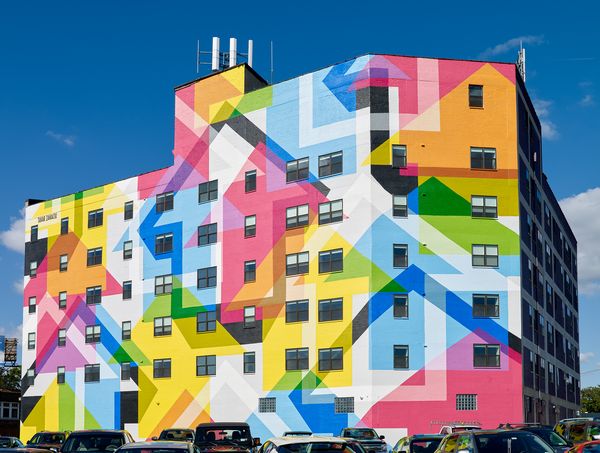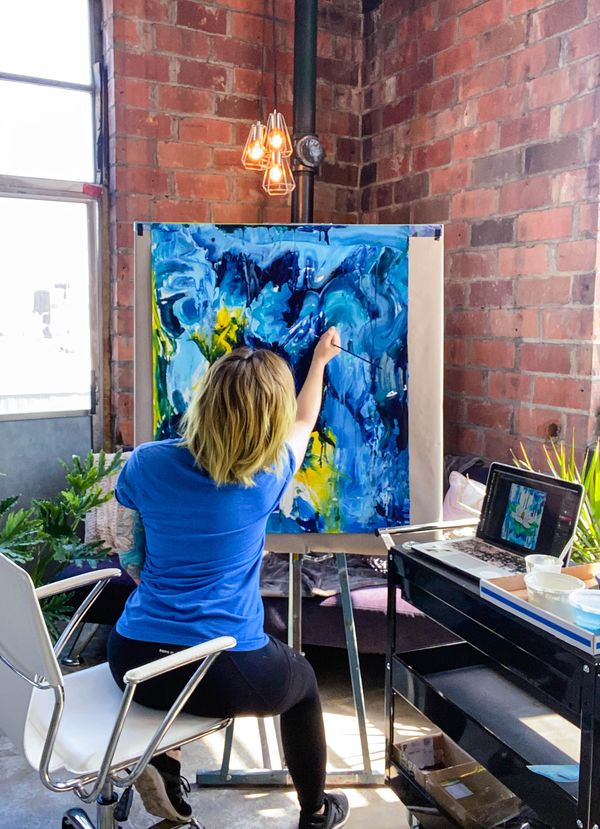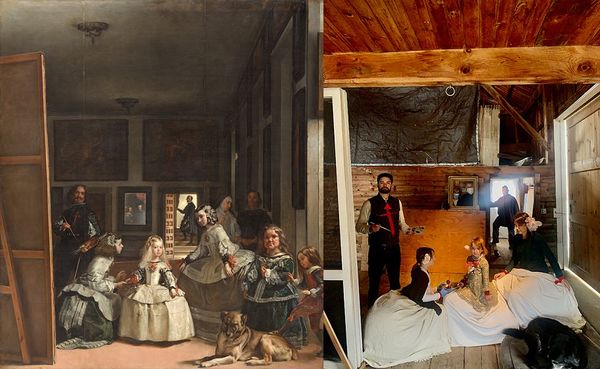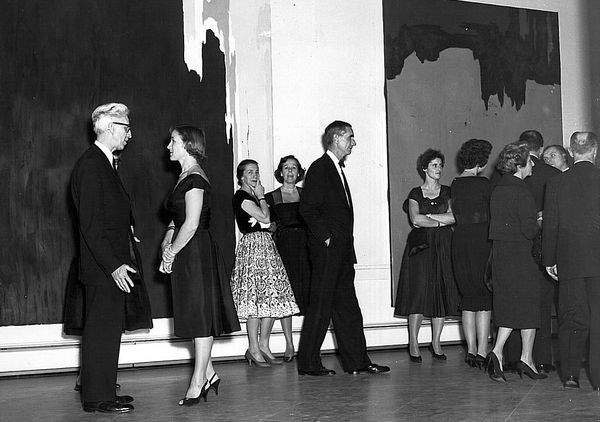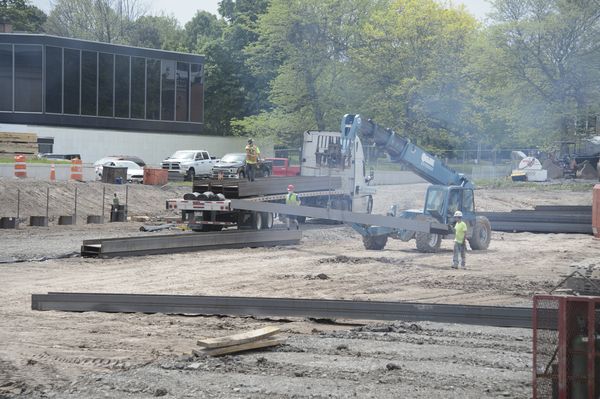A rendering of Albright-Knox's new Gundlach Building, as seen from the 1905 portico.
PHILLIPS: You are originally from Finland. How has your experience at European institutions affected the way in which you approach your position at the Albright-Knox?
JANNE SIRÉN: I worked as director of two public art museums in Finland for a total of nine years, first at the Tampere Art Museum and then the Helsinki Art Museum, one of the largest cultural organizations in the Nordic Region. Both of these museums had robust public art programs and departments. Inspired by those experiences, in 2013, shortly after commencing my appointment at the Albright-Knox, I launched the AK Public Art Initiative here in Buffalo. Now in its seventh year, the Initiative oversees a robust public art program in collaboration with Erie County and the City of Buffalo.
Tavar Zawacki's mural Metamorphosis #5 at 1665 Main Street in Buffalo. Photograph by Tom Loonan and Brenda Bieger.
Finnish art museums also prioritize community engagement in all aspects of their operations and this is certainly something that has guided my role at the Albright-Knox. In January this year, we opened Albright-Knox Northland, a satellite exhibition space that was once a manufacturing plant for shock absorbers and other car parts.
Opening this new location allowed us to branch out into neighborhoods in Buffalo that have historically been underserved. We began transitioning a portion of our traditional marketing dollars into community-based sponsorships that, in turn, help other organizations serve the area. This is an ongoing process that will enable us to engage wider and more diverse local audiences while welcoming visitors to Buffalo from around the world. We are currently in the process of building our future and in 2022 will reopen our main campus as the Buffalo AKG Art Museum.
P: Do you find that the recent challenges have allowed for positive developments in the museum’s engagement with the public?
JS: Community engagement is one of the Albright-Knox’s strategic priorities, a cornerstone of our 21st-century DNA, and the COVID-19 pandemic has compelled us to reach for new levels of innovation on this front. I am tremendously proud of our team and what they have been able to accomplish during this period characterized by social distancing and remote work protocols. With doors temporarily closed at cultural organizations across New York State, in April we launched an initiative entitled #WNYCulturalConnections. This new platform enables cultural institutions in Western New York to collaborate and share resources and best practices with each other. Participating cultural organizations are using the hashtag on social media in order to make it easier for members of the public to search for and benefit from the educational and entertaining content these organizations produce and share each week. From virtual tours to at-home children’s activities, the content appeals to a large audience with varied interests. Collaboration and community partnerships are the keys to success during this global crisis. The lessons we learn now will fortify our future.
In-progress detail from Works, from Home participating artist Ashley Johnson. Image courtesy of the artist.
Our Public Art Department, to highlight one example, has partnered with sixteen artists throughout Western New York to create Works, From Home.
This innovative project will result in the co-creation of a mural, painted in sections in each artist’s own home or studio, that will be installed after the COVID-19 crisis is in our rearview mirror. Each artist will work with materials provided by the museum and will document their progress on their personal social media channels using the hashtags #AKPublicArt and #WorksFromHome.
An interpretation of Las Meninas from the annual Art Alive contest.
Our Education Department has worked to make many at-home art activities and programs available on our website. We are also very excited with the wonderful turnout for the virtual edition of our annual Art Alive contest. This year we received nearly 300 entries, which is an increase of roughly 1500%!
Finally, in an attempt to keep museum stakeholders well-informed with updated information regarding the museum’s AK360 Campus Development and Expansion project, a $185 million endeavor, in early April this year I launched the Director’s Vlog, a video diary of sorts.
Through each of these new initiatives, we have been able to substantially increase the museum’s presence in the lives of the many people who rely on it for art, inspiration, and visions of the future.
Works by Clyfford Still on view in the 1905 building, with the artist himself present to the left.
P: What are some of the hidden gems at the Albright-Knox?
JS: Insofar as our collection is concerned, there are too many hidden gems to name! One reason for that is that we have been committed to collecting the art of our time for 157 years – we are the sixth oldest art museum in the US and one of the first anywhere dedicated to collecting the work of living artists. Visionary collectors and curators since our inception have sought to identify the revolutions of tomorrow before tomorrow recognizes them as such, and as a result, all the major aesthetic innovations of the past century-and-a-half have a place in our collection. Unfortunately, due to the physical limitations of our historic campus, we have only been able to share about 2-3% of our collection with the public at any given time. When our new campus opens in 2022, this will change. The Buffalo AKG Art Museum will have more than double the exhibition space, allowing us to share more artistic gems with our visitors than ever before. I cannot wait for us to put our extraordinary paintings by Clyfford Still on view in a dedicated gallery— we have thirty-three works by him, covering all periods of his career.
I also think our presentation of Marisol Escobar’s work will be eye-opening, to say the least. Marisol passed away in 2016, leaving her entire estate to us, including her archives and roughly 1,000 works in different media, and there are so many pieces in that collection that have never been seen in public.
Aerial rendering of the expanded Albright-Knox campus.
P: Can you tell us a bit about the campus development project you are undertaking?
JS: For more than a decade we have explored the possibility of expanding and upgrading our facilities. These enhancements are urgently needed to properly house the Albright-Knox’s world-renowned collection of modern and contemporary art. We also want to organize special exhibitions with our peer institutions and present a dynamic array of complementary educational and community-oriented programs. In 2014, the museum’s Board of Directors unanimously resolved to launch AK360, the largest cultural development project in the history of our region.
We are very lucky to have brilliant architectural partners who are able to give physical shape to our future vision. Our design architect is OMA/Shohei Shigematsu and our executive architect is Cooper Robertson with Jason Cadorette as the lead. The OMA and Cooper Robertson teams are simply amazing, and I am always impressed by their ability to come up with beautiful solutions in response to our operational needs.
Ongoing construction work on the Albright-Knox campus.
Projects like this are massive endeavors that require the knowhow of hundreds of professionals from different fields of expertise. I have learned so much about design, construction and management throughout this project. We are currently in the mass excavation phase of the project and expect to open our new, revitalized museum, the Buffalo AKG Art Museum, to the public in 2022.
Upon reopening, we will have a brand-new museum building, the Gundlach Building, that will complement the other structures on our campus. The new building alone will add 30,000 square feet of prime exhibition space to our campus and it will also incorporate several visitor amenities, including an indoor promenade that wraps around the new building. The views from this space to the surrounding landscape, a Frederick Law Olmsted park, will be stunning.
The creation of the Buffalo AKG Art Museum is not just a physical construction project. We are also committing ourselves to implement and practice the principles of diversity, equity, accessibility, and inclusion throughout every level of our organization. Our goal is to serve as a resource for all of Western New York, and a core element of achieving that is breaking down the barriers and obstacles that have historically obstructed the community’s access to our collection and our programs and events. As much as this monumental building project is a transformative event in the history of the museum, it will also have an immense impact on the cultural life of Buffalo and for all the audiences we aspire to serve inclusively.
P: Thinking globally, is there a particular exhibition, artist project or public program that you are looking forward to?
Besides the Buffalo AKG Art Museum’s own slate of reopening exhibitions and installations scheduled for 2022, which will consist of the largest presentation of our collection ever, I am really looking forward to gathering more generally with peers and with artists to look at art. Coming together to debate, to reflect, and to absorb is so important. Art gains its meanings, its cultural impact, through social dialogue, something I’ve really missed these past few months, whether that be in artist studios, in galleries, or in the context of larger exhibitions. I miss all my artist friends and colleagues across the world.
Janne Sirén and Anselm Kiefer in conversation.
In my capacity as the President of the Eschaton Kunststiftung, the Anselm Kiefer Foundation, I am also eager to see what Anselm has created in his studio during this global crisis. He is an artist who takes the long view on history and who has an uncanny ability to embrace history and the world of myths and mystery through his art. I continue to learn so much from him and cannot wait to be in his studio again soon.
Learn more about Albright-Knox >

